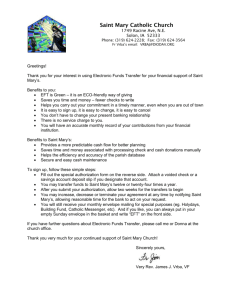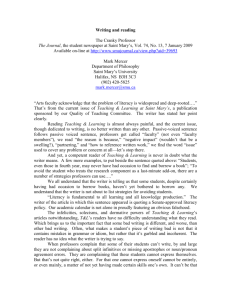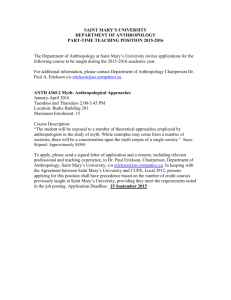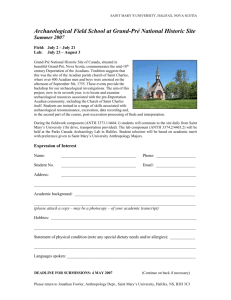Against Official Course Evaluation Forms
advertisement
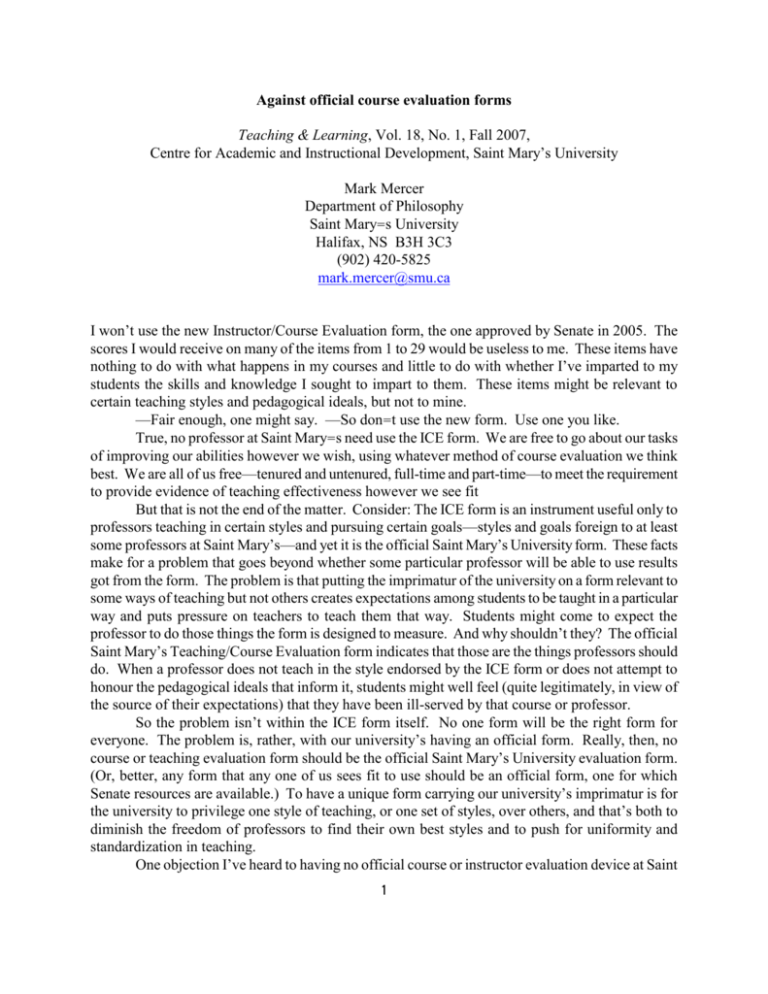
Against official course evaluation forms Teaching & Learning, Vol. 18, No. 1, Fall 2007, Centre for Academic and Instructional Development, Saint Mary’s University Mark Mercer Department of Philosophy Saint Mary=s University Halifax, NS B3H 3C3 (902) 420-5825 mark.mercer@smu.ca I won’t use the new Instructor/Course Evaluation form, the one approved by Senate in 2005. The scores I would receive on many of the items from 1 to 29 would be useless to me. These items have nothing to do with what happens in my courses and little to do with whether I’ve imparted to my students the skills and knowledge I sought to impart to them. These items might be relevant to certain teaching styles and pedagogical ideals, but not to mine. —Fair enough, one might say. —So don=t use the new form. Use one you like. True, no professor at Saint Mary=s need use the ICE form. We are free to go about our tasks of improving our abilities however we wish, using whatever method of course evaluation we think best. We are all of us free—tenured and untenured, full-time and part-time—to meet the requirement to provide evidence of teaching effectiveness however we see fit But that is not the end of the matter. Consider: The ICE form is an instrument useful only to professors teaching in certain styles and pursuing certain goals—styles and goals foreign to at least some professors at Saint Mary’s—and yet it is the official Saint Mary’s University form. These facts make for a problem that goes beyond whether some particular professor will be able to use results got from the form. The problem is that putting the imprimatur of the university on a form relevant to some ways of teaching but not others creates expectations among students to be taught in a particular way and puts pressure on teachers to teach them that way. Students might come to expect the professor to do those things the form is designed to measure. And why shouldn’t they? The official Saint Mary’s Teaching/Course Evaluation form indicates that those are the things professors should do. When a professor does not teach in the style endorsed by the ICE form or does not attempt to honour the pedagogical ideals that inform it, students might well feel (quite legitimately, in view of the source of their expectations) that they have been ill-served by that course or professor. So the problem isn’t within the ICE form itself. No one form will be the right form for everyone. The problem is, rather, with our university’s having an official form. Really, then, no course or teaching evaluation form should be the official Saint Mary’s University evaluation form. (Or, better, any form that any one of us sees fit to use should be an official form, one for which Senate resources are available.) To have a unique form carrying our university’s imprimatur is for the university to privilege one style of teaching, or one set of styles, over others, and that’s both to diminish the freedom of professors to find their own best styles and to push for uniformity and standardization in teaching. One objection I’ve heard to having no official course or instructor evaluation device at Saint 1 Mary’s concerns items 30 and 31, the items in which students rate the course and the professor. The objection is that results from items 30 and 31 will be useless to professors, Deans, and committees as evidence of teaching effectiveness unless those results come from a standard form used by a majority of professors. Suppose we all include items 30 and 31 from ICE on our own evaluation forms (I have them on mine). Students making comparative evaluations of professors over a plethora of forms would be comparing apples with oranges with tool sheds. Administrators deciding on tenure or promotion would, then, in turn, lack a piece of meaningful evidence relevant to where on the scale of good teaching the candidate sits. First, of course, the objection agrees that the effect of having an official Saint Mary’s form might well be uniformity and standardization in teaching. Narrowing the range of styles and ideals to be found at Saint Mary’s is something the objection takes as desirable—if not in itself, at least as helpful in bringing some order to the rough and tumble business of granting or denying tenure or promotion. Second, though, the objection presupposes that one can’t evaluate apples against oranges or either against tool sheds. But of course one can; we do it all the time. It’s called judgement. In fact, I say, one of the most important tasks we have as professors is to help our students to develop their faculty of judgement. Our goal is to create people who can evaluate apples against oranges against tool sheds soundly. Or, at least, so according to one pedagogical ideal I attempt in my practice to honour. B30B 2

